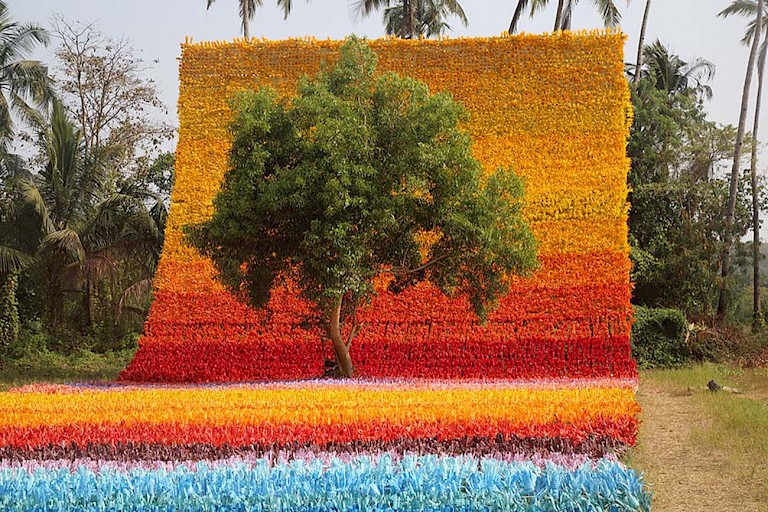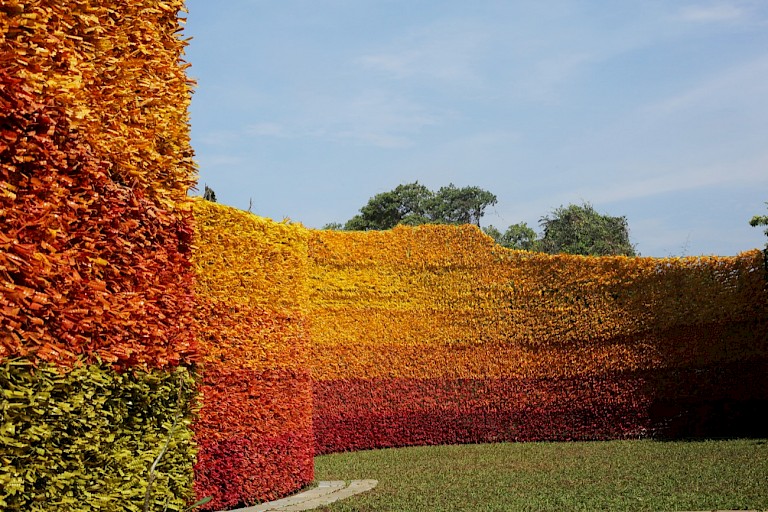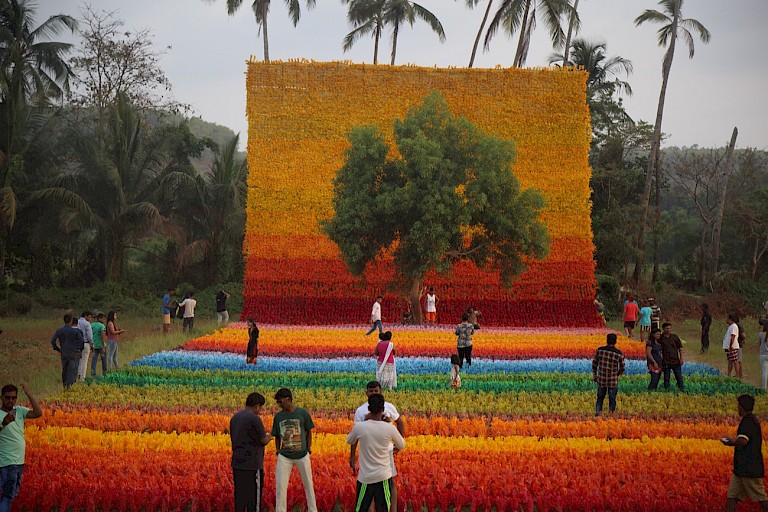



The Artist
Subodh Kerkar is a renowned Indian artist who seamlessly marries the realms of visual arts and the coastal landscapes of Goa, his home. Initially trained as a doctor, Kerkar's passion for art led him to pivot his career, and he has since dedicated over three decades to creating awe-inspiring installations and sculptures. His works, predominantly large-scale, are deeply influenced by the Arabian Sea's tides, rhythms, and stories, often using materials sourced from the sea itself.
Kerkar's art transcends the tangible; it is a dialogue between nature, history, and contemporary issues. He is particularly acclaimed for his innovative fusion of traditional Indian art forms with contemporary techniques and themes. His installations not only reflect on the cultural and historical intricacies of Goa but also touch upon broader global issues like migration, colonialism, and environmental concerns.
In addition to his artistic pursuits, Kerkar has been instrumental in transforming Goa's art scene. He founded the Museum of Goa (MOG), which has emerged as a dynamic space for artists, locals, and tourists, fostering discussions, exhibitions, and collaborations. Through his art and initiatives, Kerkar continues to inspire, provoke thought, and celebrate the confluence of past and present.
"The Carpet of Joy, unveiled at the Saligao Circle, represents a brilliant fusion of art, activism, and environmentalism. Its inception, creation, and unveiling involve numerous stages, illustrating how art can serve as an agent for change, both ecologically and socially.
1. Inspiration:
The driving force behind this massive installation is Goan sculptor Dr. Subodh Kerkar. Inspired by Mahatma Gandhi’s satyagraha movement that protested against injustices by British laws, Kerkar wanted to use his art to mark the centenary of the historic day by addressing the "act of violence" of littering, especially with plastics. Kerkar's inspiration further expanded when he encountered the works of Israeli architect, Uri De Beer, renowned for 'Plastiflora', a smaller-scale art piece that transformed plastic waste into beautiful art installations.
2. Collaboration and Collection:
The project was a collective endeavor from the get-go. Approximately 3,000 local students participated in collecting the 1,50,000 discarded plastic bottles required for the installation. The bottles were sourced from beaches, hotels, and the general public of Goa. Hotels contributed their plastic waste, and the broader Goan community also provided spontaneous support, seeing the potential for a message against the littering problem plaguing their state.
3. Creation Process:
In transforming these discarded bottles into an art installation, about 1,500 liters of paint was used to color them vibrantly. Emulating the 'Plastiflora' technique by Uri De Beer, each bottle was crafted to resemble flowers. Students were entrusted with 15-20 bottles each, using scissors to shape them into flower-like designs. The methodology employed a plastic net, where the openings of the bottles were fixed onto the net's holes, creating a vast carpet over the field.
Strategically placed next to a main road, the Carpet of Joy was spread across 100 meters of field land near Saligao Circle. Its visibility was intentional, ensuring that travelers, tourists, and locals would be drawn to its vibrancy, only to be introduced to its profound message against littering.
5. Engaging the Public:
The installation was designed to not only be a spectacle but an interactive platform. A viewing podium was erected, allowing visitors to see the installation from a wide-angle perspective. This platform also served a dual purpose, as people were encouraged to take an 'anti-litter' oath there, reaffirming the installation's core message.
6. Educational Undertone:
Dr. Kerkar believes in the power of education to bring about lasting change. Engaging children in the creation process of the Carpet of Joy was pivotal. By involving them, the message of anti-littering would be rooted in the next generation, a crucial step as many adults already have set behaviors. The Museum of Goa partnered with 10 schools for a waste management program, and students were educated on the importance of waste management and the environmental repercussions of littering.
7. Support and Funding:
7.支持和资金:
The local Panchayat of Saligao circle supported the project, allowing it to be displayed for two months. The inauguration attracted three ministers, signifying governmental acknowledgment and support. Additionally, funding for the installation was garnered through a crowdfunding campaign, underlining community and global interest in the initiative.
In essence, the Carpet of Joy, as its name suggests, isn’t just an artwork but a wake-up call—transforming discarded plastics into a beautiful, poignant reminder of our responsibilities towards our environment.
In a world grappling with the relentless environmental impact of plastic waste, 'The Carpet of Joy' stands as an evocative testament to how art, activism, and community engagement can intersect to create powerful social change.
1. Raising Environmental Awareness:
The sheer magnitude of 'The Carpet of Joy', isn't just a spectacle of color and creativity but a visual representation of the plastic waste we generate. With each plastic bottle repurposed into a vibrant flower, the art installation accentuates the stark contrast between nature's beauty and the invasive ugliness of discarded plastics. For anyone passing by or visiting, the message is clear: our wasteful behaviors have consequences.
2. Inspiring Community Engagement:
Art often remains a distant spectacle, admired from afar. However, 'The Carpet of Joy' broke those barriers by actively involving the community in its creation. The initiative required 3,000 local students to collect and craft discarded bottles into the installation's many 'flowers'. With hotels and the public donating waste, the installation grew into a communal project, fostering a sense of ownership and responsibility amongst the contributors. This active participation undoubtedly imprinted a lasting lesson about waste management and conservation on each participant.
3. Educating the Next Generation:
Children are the stewards of the future. Dr. Kerkar's choice to involve students in the creation process was strategic. By engaging with the art and understanding the message behind it, these students were more likely to grow up with an ingrained sense of environmental responsibility. The partnering of the Museum of Goa with 10 schools for a waste management program further underscored the commitment to education. Such educational undertones aimed to cultivate a generation more attuned to sustainable practices than their predecessors.
4. Promoting Active Participation:
Beyond its visual impact, 'The Carpet of Joy' served as an interactive platform. The erected viewing podium wasn't just for sightseeing; it was a place where visitors took an 'anti-litter' oath. This simple yet profound act pushed individuals to make a personal commitment against littering, turning passive spectators into active environmental advocates.
5. Gaining Governmental Recognition:
5.获得政府认可:
The presence of three ministers at the inauguration indicated that the project wasn't just a local endeavor but had managed to capture the attention of governmental bodies. This recognition is crucial, as it sets the stage for broader policy changes and support for similar initiatives in the future.
6. Catalyzing Further Initiatives:
The Carpet of Joy isn't an endpoint but a beginning. With plans for ‘prabhat pheris’ and art-driven programs to document littering violations, the momentum generated by the installation is expected to carry forward. Such initiatives will ensure that the message of 'The Carpet of Joy' continues to resonate, even after its physical presence fades.
7. Global Relevance and Inspiration:
In a world where environmental issues know no boundaries, the universal message of 'The Carpet of Joy' serves as an inspiration for global communities. Through crowdfunding, the project already tapped into global interest, illustrating the universal appeal and relevance of its message.





